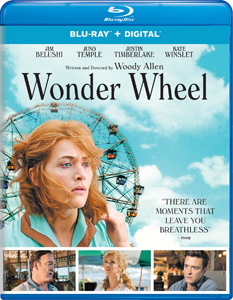I’m a sucker for movies set in amusement parks, which makes me both adore “Wonder Wheel” (2017) and judge it harshly. The colorful 1950s Coney Island backdrop is often supplemented by red-haired Kate Winslet or strawberry blonde Juno Temple.
The people and place combine into the visual equivalent of cotton candy under the lens of Vittorio Storaro, in the second of his four-straight Woody Allen films.
In the park, not of the park
But “Wonder Wheel” doesn’t live and breathe in the hustle and bustle of the park – which is loathed by clam-shack waitress Ginny (Winslet). It lives on the stage; this could easily be adapted into a dramatic play.

“Wonder Wheel” (2017)
Director: Woody Allen
Writer: Woody Allen
Stars: Kate Winslet, Justin Timberlake, Juno Temple
The main setting is the cramped on-site apartment that looks out on the titular Ferris wheel. Ginny lives with husband Humpty (Jim Belushi) and her son Richie (Jack Gore). Humpty’s adult daughter Carolina (Temple), also a waitress, is staying with them, aiming to save up for a better life after escaping her first marriage to a gangster.
For once in an Allen film, the apartments that are labeled “hovels” actually are; Mickey’s (Justin Timberlake) Greenwich Village pad also fits the bill, with a bathtub in the foyer. Mickey is an aspiring playwright and Ginny and Humpty (a ride attendant) work in the park, and their living situations are believable for the era – and nostalgically tasty today.
Ginny always wants to get away from the noise, so “Wonder Wheel” is mostly set in quiet corners, such as a spot under the boardwalk where she conjugates with lifeguard Mickey, who narrates his perspective on events. Allen sets us up for a big, colorful movie but slyly makes a small character piece.
Temple stands out
In a movie where the Woody Allen Character is young Richie, who always sneaks off to the movies (and also lights random fires, for some reason), Winslet is asked to carry the show. She’s fine, but not in the same league as Cate Blanchett in the superior “Blue Jasmine.”
Timberlake is solid, trying the hardest of the cast for a Coney Island accent, and Belushi is exactly what he needs to be as a wifebeater-wearing schlub (who does indeed beat his wife when drunk).
Temple stands out, though. Storaro’s lens adores her, whether she’s in rain light or candlelight, and the thread of Mickey falling in love with Carolina is a no-brainer.
The love rectangle isn’t as compelling as in “Café Society.” Here, most of the beats are expected, like in an old stage play. But there are some delicious scenes of the type where one character knows something but another one doesn’t, and we get to soak up the performances. Their faces are often lit in some distinct light, like we’re viewing visual (albeit moving) art.
Like a stage play
This is a matter of taste, but I would’ve liked more of the everyday activities of Coney Island. Every scene involves someone’s drama, and with Humpty and Ginny both being addicts of some type, there’s a lot of yelling and frustration and anger.
(Muting this somewhat is the use of large chunks of period songs as interludes, including “Coney Island Washboard” and “Harbor Lights.”)
The contrast to the backdrop of people having fun doesn’t pop like it could have. And no part of “Wonder Wheel” sneaks up on a viewer like Allen’s elite films do, where you think you know what you’re watching but receive subtly deeper insight that sticks with you.
“Wonder Wheel” is easily worth watching anyway if you’re an Allen fan, but Temple – who should be a better-known movie star (as I’ve thought in every small roles she’s in) — clinches it. Carolina remains a vision against a vibrant backdrop that tries its darnedest to rub her out.


